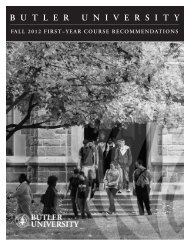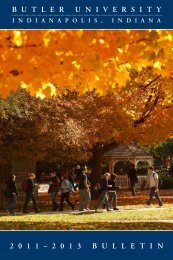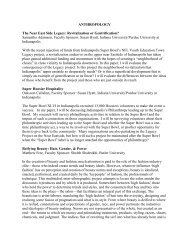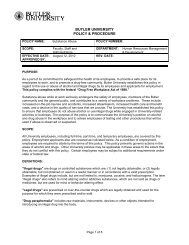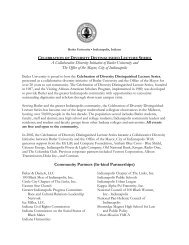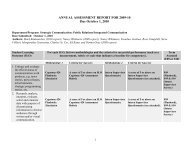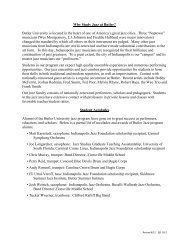Student Handbook - Butler University
Student Handbook - Butler University
Student Handbook - Butler University
You also want an ePaper? Increase the reach of your titles
YUMPU automatically turns print PDFs into web optimized ePapers that Google loves.
dismissal and/or separation from the <strong>University</strong>. Alleged violators may also be subject to prosecution<br />
under relevant local and/or federal law.<br />
XIII. Hazing and Pre-initiation Activities<br />
1. Hazing is any action taken or situation created intentionally that places an expectation on a person<br />
joining or maintaining full status in a group that is not consistent with requirements for<br />
membership, team rules, university regulations and policies, and/or fraternal law or ritual, as<br />
applicable. Conduct that may be considered hazing is as follows:<br />
(a) Has the potential to produce emotional, psychological or physical discomfort, embarrassment,<br />
harassment or ridicule<br />
(b) Can occur on or off campus<br />
(c) Can occur regardless of the person’s willingness to participate<br />
(d) Is prohibited by the criminal code of the State of Indiana<br />
2. <strong>Butler</strong> <strong>University</strong> believes that hazing is non-productive, violates students’ rights, and has no<br />
place in the campus community. Hazing activity may lead to disciplinary action for individuals<br />
as well as a student group, organization, or team.<br />
3. It is impossible to list all possible hazing behaviors because many are context-specific. The following<br />
list provides categorical examples of hazing traditions:<br />
Subtle hazing – behaviors that emphasize a power imbalance between members of the group<br />
and those who desire to be accepted. Subtle hazing typically involves activities or attitudes that<br />
breach reasonable standards for mutual respect. Some examples:<br />
(a) Deception<br />
(b) Requiring new members to perform duties not assigned to other members<br />
(c) Deprivation of privileges granted to other members<br />
(d) Expecting certain items to always be in one’s possession<br />
(e) Requiring new members to refer to members with titles (e.g., Mr., Miss) while new members<br />
are identified by a term instead of by name<br />
(f) Use/misuse of ritual symbolism outside of organization’s approved ceremonies<br />
(g) Walking/running/sitting/standing in formation<br />
Harassment hazing – behaviors that cause emotional anguish or physical discomfort required<br />
of those joining the group. Harassment hazing confuses and frustrates, and causes undue stress<br />
for those joining the group. Some examples:<br />
(a) Verbal abuse<br />
(b) Intimidation or implied threats<br />
(c) Personal servitude<br />
(d) Sleep deprivation<br />
(e) Degrading or humiliating activities<br />
(f) Interference with personal hygiene<br />
Violent hazing – behaviors that have the potential to cause physical and/or emotional or psychological<br />
harm. Some examples:<br />
(a) Forced/coerced ingestion of alcohol or any other substance<br />
(b) Beating or paddling<br />
(c) Branding<br />
(d) Abuse or mistreatment of animals<br />
(e) Public nudity<br />
110



